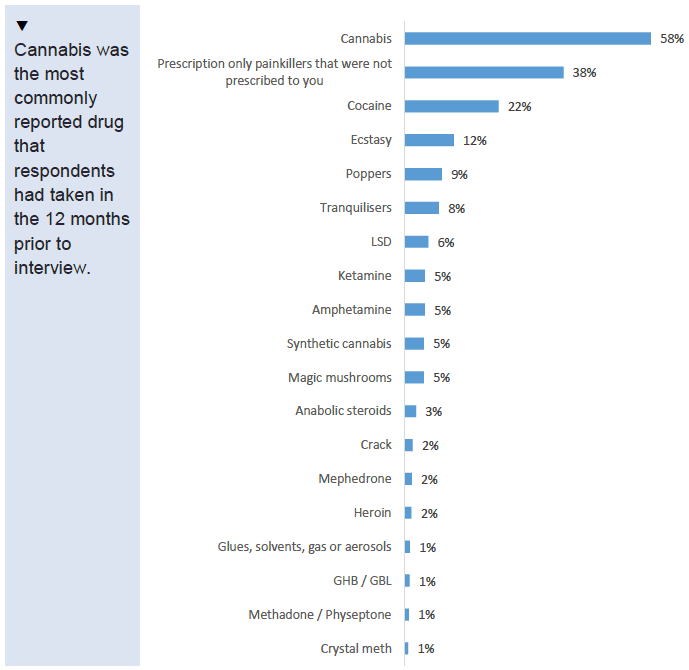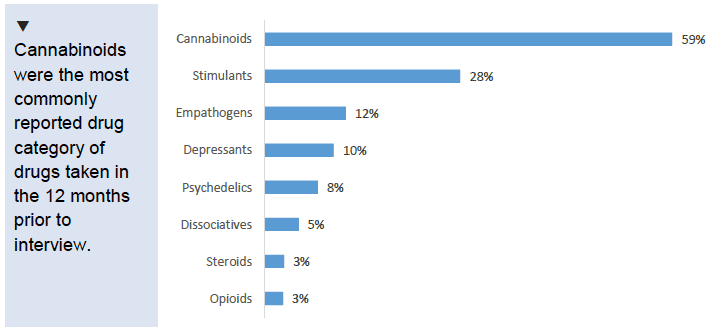Scottish Crime and Justice Survey 2019/20: main findings
Main findings from the Scottish Crime and Justice Survey 2019/2020, including self-completion findings covering the period 2018/19 to 2019/20.
This document is part of a collection
9.1 Illicit Drug Use
The aim of the illicit drug use section of the questionnaire is to provide an insight into the prevalence of drug use in Scotland amongst those aged 16 and over. The results in this section focus on drug use in the 12 months prior to interview.[140]
The latest results presented below are from two survey years of the SCJS combined (2018/19 and 2019/20). This is referred to throughout the section as 2018/20. Note however that the illicit drugs data for previous years refers to individual years (the last being 2017/18). For more information, see the Technical Report.
Drugs included
Respondents were asked about their usage of 19 drugs.[141] The majority of these drugs were illicit at the time of the survey, but the list also included some drugs which were not controlled. These were namely poppers, glues, solvents, gas or aerosol. These have been included in analysis of adults reporting drug use in Scotland. Any analysis that excludes the drugs which are not illicit clearly states so.
The drugs are categorised in some of the analysis by composite group in accordance with the Drugs Wheel[142] : cannabinoids, stimulants, opioids, depressants, psychedelics, dissociatives, empathogens, and an additional category of steroids; and by their classification: Class A, B or C (as defined in the Misuse of Drugs Act 1971). A full list of the drugs and their categorisations can be found in Annex D.
It is important to note that drug use is a dynamic area with new substances appearing on the market and relatively frequent changes to legal classification. This is reflected in the survey questionnaire design.
For example, most novel psychoactive substances (sometimes known as 'legal highs') are now covered by the Psychoactive Substances Act 2016, with some explicitly listed under the Misuse of Drugs Act. Other drugs, such as ketamine, have been reclassified within the Misuse of Drugs Act. These changes in classification have the potential to impact on overall rates of illicit drug use.
New drugs which were not previously widely available have also been included in the survey, for example GHB/GBL was included for the first time in the 2017/18 survey but was not in the preceding survey years. Most new drugs included only account for a small proportion of reported drug usage, for example in 2018/20 0.2% of respondents reported ever taking GHB/GBL. Alternatively, some drugs which were previously asked about in the survey are no longer included. Therefore, any comparisons made with previous years in this section should be treated with caution.
What was the prevalence of drug use in Scotland in 2018/20?
Between 2017/18 and 2018/20, self-reported drug use has increased from 9.5% to 13.5%.
The drugs listed in the survey questionnaire[143] have remained the same since 2017/18, which allows for direct comparisons to be made between the two time periods.
In 2018/20, 13.5% of respondents reported taking one or more of these drugs in the 12 months prior to interview. This has increased from 9.5% in 2017/18.
Eleven of the 19 drugs asked about in the survey have seen increases since 2017/18 in the proportion of respondents having taken them in the 12 months prior to interview. These included prescription only painkillers that were not prescribed to the respondent (increased from 3.3% to 5.1%), cannabis (6.6% to 7.9%), and cocaine (1.8% to 3.0%). Figures on the proportion of adults who reported using each individual listed drug in the 12 months prior to interview are available in the supporting online data tables.
Looking at comparable measures, where the drug types included in the survey are generally consistent over time, drug use has increased since 2008/09 and 2017/18.
In order to have a more comparable measure over the longer time period (since 2008/09), the 2018/20 figures in this section exclude prescription only painkillers that were not prescribed to the respondent.[144] Non-illicit drugs (poppers, glues, solvents, gas and aerosols) are also excluded.
In 2018/20, 9.7% of respondents reported taking one or more of these drugs in the 12 months prior to interview. This has increased from 7.6% in 2008/09 and 7.4% in 2017/18, as shown in Table 9.1.
| Time period | 2008/09 | 2009/10 | 2010/11 | 2012/13 | 2014/15 | 2017/18 | Percentage point change | ||
|---|---|---|---|---|---|---|---|---|---|
| 2018/20 | Change since 2008/09 | Change since 2017/18 | |||||||
| In the last 12 months | 7.6% | 7.2% | 6.6% | 6.2% | 6.0% | 7.4% | 9.7% | ↑ by 2.1 | ↑ by 2.3 |
| Number of respondents | 10,960 | 13,410 | 10,980 | 10,220 | 9,970 | 4,880 | 9,590 | ||
Variable: Q12M_ANY.
The most commonly reported drug used in the 12 months prior to interview was cannabis.
Fewer than one-in-ten respondents (7.9%) said they had taken cannabis in the 12 months prior to interview. Of those respondents who reported taking drugs in the 12 months prior to interview, over half (58%) said they had taken cannabis. This is a decrease from 70% in 2017/18.
Of those who had taken cannabis in the 12 months prior to interview, just under half (49%) had not taken any other drugs in the same time period. This is a decrease from 59% in 2017/18.
The survey also provides the estimates on use of synthetic cannabis (also known as 'spice'). Of those who had taken drugs in the 12 months prior to interview, 5% said they had taken synthetic cannabis, unchanged from 2017/18.
Figure 9.1 below shows the drugs taken in the 12 months prior to interview as a proportion of those who had taken any drug in the same time period.

Base: All respondents taking drugs in the 12 months prior to interview (1,120). Variable: Q12M.
The percentages total to more than 100% as respondents could select multiple answers.
Cannabinoids were the most common category of drug taken.
Drugs included in the survey were grouped into categories using the Drugs Wheel;[145] more information of these groups, and drug classes, is outlined in Annex D.
Of those who reported taking drugs in the 12 months prior to interview, the most common category of drug taken was cannabinoids (59%). Figure 9.2 shows the percentages who reported taking each category of drug in the 12 months prior to interview.

Class B were the most common class of drug taken.
Class B (which includes cannabis) were the most commonly taken class of drugs in the 12 months prior to interview, with 61% of respondents who had taken any drug in the 12 months prior to interview having taken a Class B drug; 30% of respondents a Class A drug; and 11% a Class C drug. Although not presented in this summary report, if comparing changes in the use of different classes of drugs over time, it is important to note that the classifications of certain drugs (for example ketamine) have changed over time, which may contribute to changes in the different class groups over time.
2.6% of respondents reported taking 'legal highs' in their lifetime.
Respondents were also asked if they had ever taken 'legal highs',[146] known as novel psychoactive substances (NPS), even if it was a long time ago. Out of all respondents, 2.6% reported that they had. This was higher amongst men (3.5% compared to 1.6% of women) and those aged between 16 and 24 and 25 and 44 (4.9% and 5.0%, respectively) than those aged 45 to 59 and 60 and over (1.4% and 0.1%, respectively).
Are some population groups more likely to have used drugs?
The percentage of respondents who reported taking drugs in the 12 months prior to interview varied by characteristics of the respondents such as their gender, age, victim status,[147] area deprivation and rurality. Table 9.2 below shows the percentage of all respondents who reported taking drugs in the 12 months prior to interview, by these characteristics.
Note the figures in this section exclude prescription only painkillers that were not prescribed to the respondent to enable better comparability to previous years. Non-illicit drugs (poppers, glues, solvents, gas and aerosols) are also excluded. A breakdown of the characteristics, including these drugs, is available in the online data tables.
| Characteristics | % of adults | Base | |
|---|---|---|---|
| Gender | Male | 13.1% | 4,360 |
| Female | 6.5% | 5,230 | |
| Age | 16-24 | 23.5% | 680 |
| 25-44 | 14.7% | 2,750 | |
| 45-59 | 6.8% | 2,520 | |
| 60 and over | 1.6% | 3,650 | |
| Victim status | Victim | 14.0% | 1,060 |
| Non-victim | 9.1% | 8,530 | |
| Area deprivation | 15% most deprived | 15.1% | 1,310 |
| Rest of Scotland | 8.9% | 8,280 | |
| Rurality | Urban | 10.4% | 7,820 |
| Rural | 6.1% | 1,770 | |
| All adults | 9.7% | 9,590 |
Variable: Q12M.
Note: these figures exclude poppers, glues, solvents, gas or aerosols and prescription only painkillers that were not prescribed to the respondent.
Gender
A higher percentage of male respondents than female respondents reported taking one or more illicit drug in the 12 months prior to interview (13.1% compared to 6.5%, respectively).
Both of these measures have increased since 2008/09, with the proportion of men reporting having taken drugs in the 12 months prior to interview also increasing since 2017/18 (whereas women showed no change).
Age
The proportion of respondents taking drugs in the 12 months prior to interview decreased with age. Over one-in-five (23.5%) 16 to 24 year olds reported taking drugs in the 12 months prior to interview compared to around one-in-fifty of those aged 60 and over (1.6%).
Those aged 16 to 24 have shown no change in the proportion taking drugs in the 12 months prior to interview since 2008/09 and 2017/18, whereas those aged 45 to 59 and 60 and over have seen increased proportions reporting taking drugs in the 12 months prior to interview since 2017/18.
Victim status
Of those who were victims of SCJS crime in the main SCJS survey, 14.0% reported having taken illicit drugs in the 12 months prior to interview. This is higher than the 9.1% of those who were not classified as victims of SCJS crime.
Drug use amongst victims of crime has remained unchanged since 2008/09 and 2017/18, however drug use amongst non-victims has increased since 2008/09 and since 2017/18.
Area deprivation
Those living in the 15% most deprived areas of Scotland were more likely to report having taken illicit drugs in the 12 months prior to interview (15.1%), than those who lived in the rest of Scotland (8.9%).
Both those living in the 15% most deprived areas and the rest of Scotland have seen increases in the proportion of adults reporting taking drugs in the 12 months prior to interview since 2017/18.
Rurality
Those living in urban areas were more likely to report having taken illicit drugs in the 12 months prior to interview (10.4%), than those who lived in rural areas (6.1%).
The proportion of adults taking drugs in urban areas has increased since 2017/18 whereas the proportion in rural areas was unchanged. Both measures have seen increases since 2008/09 however.
Contact
Email: scjs@gov.scot
There is a problem
Thanks for your feedback